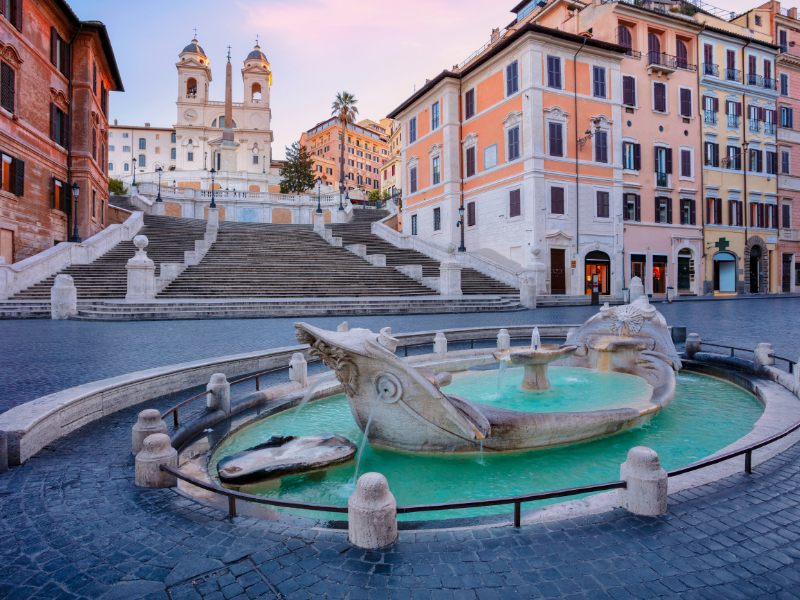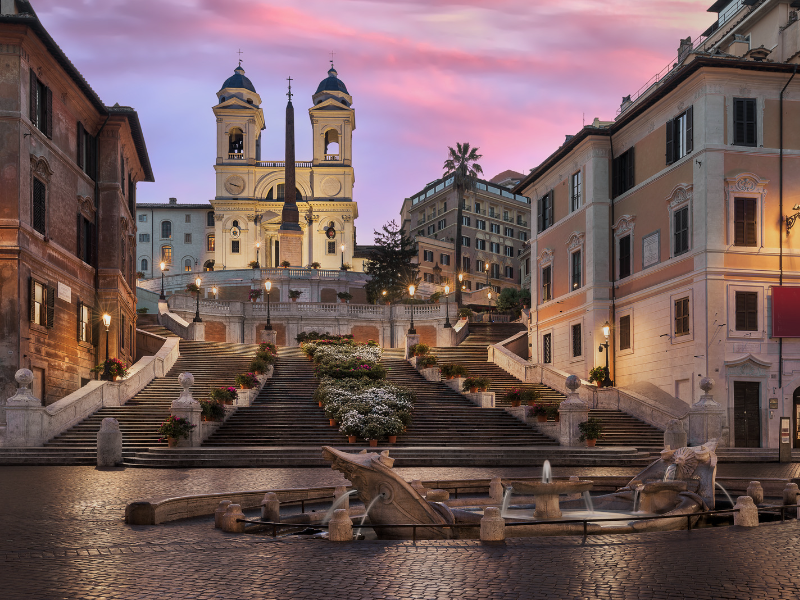Their elegant construction and lively ambiance attracts people from all over the world to sit, relax, and admire the beauty of the Eternal City. The steps were built in the early 18th century and have seen centuries of history, art, and culture pass by them, making them a must-visit destination for anyone exploring Rome.
Historical Background
Origins of the Spanish Steps
Between 1723 and 1725, with a bequest left by French diplomat Étienne Gueffier to link the Trinità dei Monti church at the top with the Spanish Embassy and Piazza di Spagna below it was financed. The architects of this structure were Francesco de Sanctis and Alessandro Specchi who intended for these staircases to increase magnificence in an area which served as meeting place between Rome’s church & statehood.
Cultural and Historical Significance
The Spanish Steps quickly became associated with elegance & sophistication; henceforth attracting artists/writers among others from across Europe who made it their business to see this place whenever they visited Italy’s capital city-state. It soon became fashionable for people go up there but also down here especially during certain periods when many events took place at or around those steps such as fashion shows thereby turning them even more into cultural symbols than before.
Famous Connections
These very steps have been depicted in literature works plus movies while still appearing on various pieces of art. One notable personality who resided near or adjacent to what has now become known as The Spanish Steps was none other than English poet John Keats during his last months alive. Furthermore, this landmark gained wider recognition after being shown in Roman Holiday – a timeless film starring Audrey Hepburn alongside Gregory Peck where one scene had them both sitting on its ledge looking down towards Piazza di Spagna.

Architectural and Design Details
Design and Structure
The Spanish Steps consist of 135 steps arranged in a series of terraces and curves leading from the Piazza di Spagna below to the Trinità dei Monti church above. They are an example of baroque architecture characterized by ornate details, sweeping lines, and grandeur proportions. The stairways are made from travertine stone which was commonly used for building materials during those times in Rome whereas its sides have balustrades made of stones lending them more stateliness.
Trinità dei Monti Church
The Trinità dei Monti is a catholic church located at the topmost part of The Spanish Steps built during Renaissance period. This magnificent structure with twin tower facades rising above piazza di spagna was originally completed towards late 15th century but later on modified several times over centuries to give it much more artistic appeal. It has got beautiful frescoes inside as well as various altarpieces that exhibit roman artistic heritage.
Fontana della Barcaccia
This is one among many baroque fountains found in different parts around Rome City which were designed by Pietro Bernini & his son Gian Lorenzo Bernini back in early 17th century AD . It represents half-sunken ship; a boat having been stranded there according to legend when Tiber river flooded its banks years ago. Among the most picturesque places where you can relax while enjoying views over this iconic spot is none other than at foot or base area right next to these famous stairs called Fontana Della Barcaccia.
Obelisk Sallustiano
Sallust’s obelisk stands in front of the Trinità dei Monti church at the top of the Spanish Steps. This Egyptian obelisk was transported to Rome and set up there during the 1700s. The antiquity it represents serves as a reminder for how long Rome has been a place of power and culture throughout history.

Spanish Steps in Roman Culture
A Place for Get Together
The Spanish Steps have always been a place of gathering for Romans as well as tourists. These large terraces and open spaces are the best location to allow people to meet, which is why this area is always teeming with activities all day.
Events and Customs
Fashion Shows
The Spanish Steps have provided an amazing site for high-end fashion shows especially during Rome’s fashion weeks. The elegance of these steps together with the surrounding area make it perfect for displaying haute couture events where people can easily see them thus attracting fashionable individuals from different parts of the world.
Flower Displays
Each spring season sees azaleas being used to decorate these steps so that they become covered with pink and white flowers creating a stunning view. This practice has its roots back in early twentieth century; besides making them more beautiful this also draws more visitors during spring months.
Artistic Inspiration
For many years artists, poets and film makers have found their inspiration at spanish steps due to its aesthetic value but also cultural significance which has seen it being featured in various movies paintings among others thus making them one of rome’s most recognizable landmarks.
Visiting Spanish Steps
Situation & Accessibility
Being situated at the heart Rome’s historic centre means that anyone can reach The Spanish Steps easily either by using public transport or walking from nearby attractions. You can walk here within few minutes if you are near Trevi Fountain, Piazza del Popolo or Villa Borghese gardens since they are not far away from each other hence making this place good for those who would wish to explore Rome on foot throughout a single day.
- Metro: Spagna (Line A) is closest subway station next right beside the stairs.
- Bus: Several bus lines like 117, 492 and 70 stop around Piazza di Spagna.
- Walking: Many of the major sights in Rome are within walking distance from the Spanish Steps so it’s very convenient to include them in your city walking tour.
Best Time to Visit
Any time is appropriate for visiting The Spanish Steps but this may vary with experience due to different times of day. If you want less crowded place and tranquil environment then early morning can be ideal moment for you. As time goes by towards late morning hours more people start coming hence making it busier until afternoon when both tourists and locals gather together enjoying vibrant atmosphere there. Evening also offers nice opportunity because steps get beautifully lit while surrounding area becomes lively with nightlife activities going on.
Practical Tips
Photography Tips
To get good pictures at Spanish Steps, consider these tips
Trinità dei Monti Church: Take photos of the church early in the morning when there is soft light and less crowd.
Fontana della Barcaccia: Try different angles of shooting the fountain so as to bring out its unique design as well reflection of steps on water surface.
Wide-Angle Lens: Use a wide-angle lens to capture entire breadth of these stairs along with adjacent buildings.
Dining and Refreshments
The Spanish Steps area has many restaurants and cafes where you can have a meal or drink while enjoying the view. Although some places may be crowded with tourists, but still there are some hidden gems:
Antico Caffè Greco: This is one of the oldest cafes in Rome and it should definitely be visited for its historical environment as well as great coffee.
Ciampini Roma: Situated near the top part of Spanish steps, Ciampini Roma offers gelato selections, pastries among other light snacks that all come along with an amazing view over the city.
Ristorante Alla Rampa: This restaurant is not far away from those stairs at all. It’s known for its cozy atmosphere and traditional Roman dishes.
Map
Nearby Attractions
Trevi Fountain
Spanish Steps are only 10 minutes’ walk from Trevi Fountain which is one of those must see landmarks in Rome. The place boasts beautiful baroque design and it also has a tradition where people throw coins into water so they could make wishes.
Piazza del Popolo
Just 15 minutes away from Spanish Steps on foot lies Piazza del Popolo that features twin churches, an Egyptian obelisk among other things; this square is also notable due to its impressive architecture while acting as gateway towards Villa Borghese gardens where one can find peace amidst hustle bustle city life.
Keats-Shelley Memorial House
Located right next door to español escaleras (Spanish Steps), Keats-Shelley Memorial House serves as a museum specifically dedicated to British Romantic poets John Keats & Percy Bysshe Shelley. These individuals lived during different periods but their works remain influential till date hence such institution should never be ignored by any ardent lover of literature.



